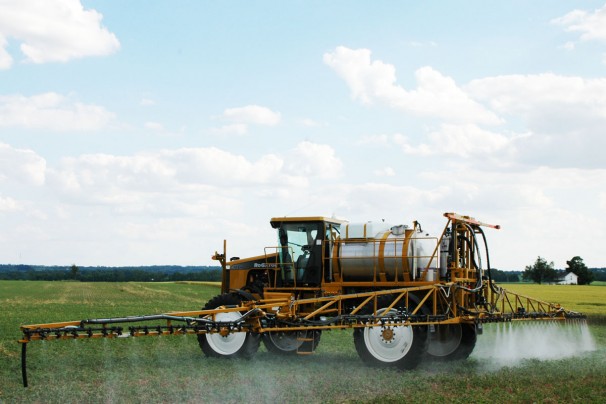Herbicide Tankmixes – 4 Tips For Improving Weed Resistance
From the very first application of a new herbicide, the targeted weed already is trying to gain resistance through those odd and infrequent mutations that make evolution possible. That initial mutation may not come forward on the first application or even after the first 1,000 treatments. But given time and enough applications, the weed will find a way around the chemistry.
those odd and infrequent mutations that make evolution possible. That initial mutation may not come forward on the first application or even after the first 1,000 treatments. But given time and enough applications, the weed will find a way around the chemistry.
That’s why sound tankmix strategies make such a significant difference in preventing or slowing resistant trends. The best tankmixes include materials that bring different modes of action (MOA) to the field and target different sites of potential resistance on troublesome weeds, says Patrick Tranel, a University of Illinois weed scientist.
Tranel was part of a team that documented the importance of tankmixing in a landmark comparison of 100 commercial fields. Their initial focus was on glyphosate-resistant waterhemp, although their findings apply to herbicide resistance across the board.
A weed species gains resistance because it has evolved, via mutations, to fit into a changing environment. In this case the environment changed when farmers shifted to a single-herbicide strategy year after year.
Tankmixing changes that environment by introducing different chemistries that fall outside of the mutation’s ability to cope.
“Early on, the probability of a weed being resistant to both Herbicide A and Herbicide B is very low,” says Tranel. “If one in a million plants are resistant to Herbicide A and the same number are resistant to Herbicide B, you’ve got about a one in a trillion chance of a single plant being resistant to both herbicides’ MOAs at the same time.”
If a weed already has developed resistance to Herbicide A, it still could be taken out by Herbicide B. That’s assuming that the existing resistance frequency for either herbicide is low. If resistance has been in play for several years, the odds shift somewhat in favor of the weeds.
Interested in Low Down Payment Financing on Self-Propelled or Pull Type Sprayers? Learn more here.
Resistance develops in phases, Tranel says, and it’s important to recognize the sequence. Generally, these include:
- Early, unnoticed resistance. The problem can be taking shape for several years, but just a handful of weeds make it through treatments on a scattered basis, so no one notices.
- Apparent resistance. In the case of the glyphosate-resistant waterhemp that the team first studied, the farmer might have noticed escapes around year 7. The frequency of escapes may only be 1% at first, but it’s enough to hopefully catch the grower’s attention. However, in many cases farmers saw weeds that slipped through but assumed that they were still doing a pretty good job. They figured that they could live with a very low level of escapes.
- The reaction or management phase. At this point, more escapes remain in the field after treatments and retreatments, so it’s obvious that something is wrong. The grower reacts to the problem and looks for new management tactics. It’s too late to prevent resistance, and if left unmanaged, resistant populations at this point can grow “exponentially” in later seasons, Tranel says.
“Early in resistance development – say, years one through three – that’s actually when you should be trying to prevent resistance from happening, even if you don’t detect it,” says Tranel. “Go with the idea that you have a problem and want to slow the rate at which it progresses, even if you don’t see any signs of it. When you get to the point where resistance is obvious, it’s too late (to think in terms of prevention).”
Tankmixes are key to making that work, he says. Of all the factors the Illinois project compared, a tankmix strategy ranked at the top in terms of minimizing resistance.
In fact, farmers who used tankmix programs early on in the study period were 80% less likely to run up against resistance 4 years later.
The key to a strong tankmix is to include 2 or even 3 materials that can each potentially kill the targeted problem weed by itself with different modes of action (MOA) at play. That sounds simple enough. But putting the right combination into play requires research about both MOAs and the growth stage of the weed, itself.
Tranel offers these 4 general guidelines or caveats about tankmix planning:
#1. Think in terms of weed “individuals” when planning tankmixes.
In this case, individuals are plants of the same species but at different and sometimes overlapping growth stages. Some perhaps have emerged while others have sprouted but are still in the soil. Still other seeds are present but haven’t germinated yet.
Your goal is to aim the tankmix at the same individual weed (or growth state). That ensures the different MOAs in the tankmix are simultaneously working on different resistant sites. If a weed can slip by one herbicide, the other herbicide still has a chance to take it out, provided it is active on the weed at that same growth stage.
“If you’re mixing a foliar-active herbicide with a residual soil-applied herbicide, those 2 materials are targeting different individuals in that field,” Tranel explains. “So, you are really only putting one MOA in play for each stage. You’re not simultaneously hitting every individual weed with dual MOAs.”
#2. Avoid using the same MOA in a tankmix.
If 2 herbicides have mostly identical MOAs, that’s often no better than applying higher rates of the same material, which simply leads to more escapes in resistant populations. We’ve all seen those images of resistant weeds that have received 2X or 3X the normal rate of active ingredient yet remained healthy. That’s about the same effect as going with 2 different products with an identical MOA.
#3. Don’t skimp on rates.
Avoid thinking that lower rates of 2 different MOAs will do the same job as a whole rate of a single MOA. Rates for either product must be high enough to kill the weed in the absence of the other herbicide. Don’t count on synergy. “With reduced rates, you don’t have an effective tankmix combination for resistance management,” Tranel says. “Enough active ingredient should be used for each material to kill the weed if the other herbicide for some reason falls short on control.”
#4. Take into account herbicide soil movement and residual activity.
With preemergence herbicides in a tankmix, remember those subtle differences in residual activity and movement through the soil.
“If you use 2 preemergence materials – one with a very short soil residual and the other with a very long soil residual – you’re trying to aim at 2 different individuals. The material with the long residual will end up targeting weeds by itself after the short-lived herbicide goes away. Essentially, the material with a longer residual life won’t have an alternate MOA to back it up.”
If a preemergence moves quickly through the soil, it also will be targeting different individuals deeper in the seedbank than a tankmix partner that remains near the surface. Again, you lose the power of 2 MOAs working together against the same individual.
Tranel admits that “even a perfect tankmix isn’t bullet proof” since there’s no guarantee that a herbicide will control every weed out there.
Ultimately, weed management has to be about more than just herbicides and must include other diverse strategies, says Tranel. Depending on the situation, that might include crop rotation, cover crops or even tillage.
Want to read the Illinois study? Click here to connect with it on the Pest Management Science website.
Managing Herbicide Resistance: Mix or Rotate? By: Patrick Tranel

